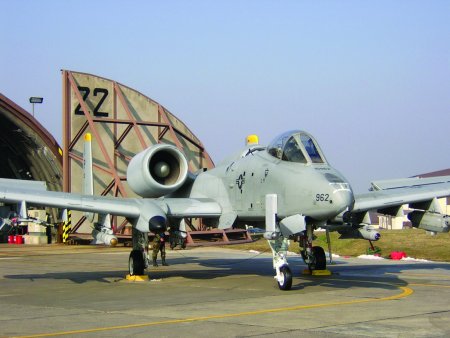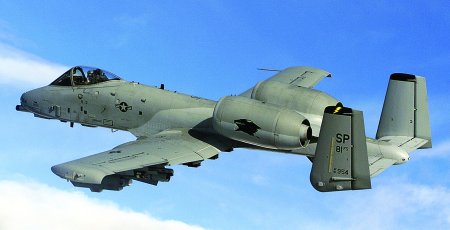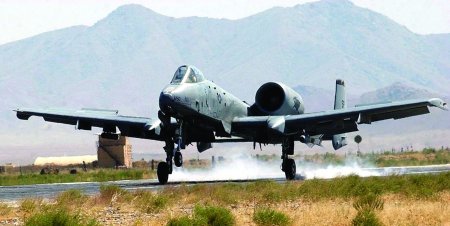The US Air Force knows that to keep its A-10 Warthog in frontline service until 2028 it needs to tackle the ground-attack aircraft's shortcomings. A key change is a precision engagement update, and upgrading the GE TF34-100 engine is a possibility
Under current planning assumptions, the US Air Force's Fairchild A/OA-10 Thunderbolt II will remain in frontline service until 2028. That represents an operational life of almost 50 years for the USAF's fleet of the ground-attack aircraft. The air force is well aware of the airframe and propulsion demands that will be created by this more than doubling of an anticipated design life of 8,000 flight hours (roughly equivalent to 20 years of operations), and it is addressing several key system shortcomings that are threatening the type's long-term utility on the modern battlefield.
An important aspect of the USAF's efforts to ensure the operational longevity of its A-10 "Warthog" fleet is a precision engagement revamp, which could lead to the modification of up to 125 active-duty aircraft by 2007 under a contract worth $200 million. Now in its $90 million engineering and manufacturing development (EMD) phase, the precision engagement update aims to equip the jet with modern reconnaissance and targeting systems, plus precision-guided weapons. These capabilities will enable A-10 pilots to identify and strike targets from stand-off range and medium altitude, keeping the aircraft out of range of surface-to-air missile threats.
The USAF will in mid-April receive its first prototype precision engagement installation kit from Lockheed Martin Systems Integration of Owego, New York, ahead of flight-test activities set to run from mid-year through most of 2005. The company has been prime contractor for A/OA-10 support since December 1997 and will deliver a further five kits to the USAF under its EMD contract, having completed a critical design review last October.
Precision engagement
Supported by BAE Systems Controls (weapon subsystems and avionics), Northrop Grumman (structural modifications) and the South West Research Institute (maintenance and support), the precision engagement effort covers fleet upgrade and sustainment issues, plus avionics and block software upgrades. Most importantly, it will enable the A-10 to operate with the Northrop Grumman Litening II/AT or Lockheed Martin Sniper XR reconnaissance and targeting pods, and the Boeing Joint Direct Attack Munition and Lockheed Martin Wind-Corrected Munitions Dispenser weapons.
This work requires the addition of an upgraded power system, 1760 weapons databus and digital stores management system, plus two multifunction displays to improve the pilot's situational awareness.
"Precision engagement is the foundation platform to keep the aircraft mission-ready until 2028," says Roger Il Grande, Lockheed Martin's A-10 programme manager. "It fits nicely with what the close air-support mission demands, and with the threats on the ground getting more sophisticated."
Col Thomas Groznik, vice-commander of the USAF's A-10-equipped 52nd Fighter Wing at Spangdahlem AB, Germany, says the enhancements are needed to ensure the aircraft's continued lethality on the battlefield. "We've had to do more with less for quite a long time in terms of avionics and weapons," he says, adding: "The promise of precision engagement and extended life excites us."
The wing's 81st Fighter Squadron is the only European-based air force unit to operate the A-10, with a current squadron strength of 23 aircraft. The unit was deployed to Afghanistan for six months last year in support of Operation Enduring Freedom, during which its aircraft were temporarily equipped with the baseline Litening pod, boosting its effectiveness. Such enhancements "are beginning to give us some stand-off range", says Groznik, who also welcomes the aircraft's recent receipt of GPS navigation.
Capt Paul Corey, an A-10 pilot with the 81st Fighter Squadron, flew convoy escort missions and provided cover for ground forces during a three-month stint at Afghanistan's Bagram AB from mid-2003. The squadron's aircraft routinely flew with a half load of around 600 30mm cannon rounds, six 225kg (500lb) Mk82 unguided bombs and two Raytheon AGM-65 Maverick air-to-surface missiles, remaining on station for 2h. This endurance could be increased to around 6h, however, with tanker support. Notable squadron firsts included full night-vision goggle take-offs and landings and the use of AGM-65H/K TV-guided missiles, which gave pilots an improved stand-off targeting capability. The aircraft were equipped with a secure datalink that enabled pilots to talk directly to terminal attack controllers on the ground.
"The more technology and situational awareness building equipment we can get in the A-10 is a good thing, and the better our employment capability will be," says Corey. In the longer term, the A-10 is also to gain a blue force tracking capability to reduce the risk of fratricide.
Next deployment
The 81st Fighter Squadron will soon deploy to Nellis AFB in Nevada for build-up training ahead of its next operational deployment - most likely a return to Bagram. Squadron officials say the A-10 is better suited to operating from the austere airfield than its 52nd Fighter Wing stablemate the Lockheed Martin F-16CJ, due to its rugged design and above fuselage-mounted engines.
One capability not addressed through the precision engagement effort, but drawing revived interest within the air force, is a long-requested upgrade or replacement of the A-10's General Electric TF34-100 turbofans. Each engine delivers a thrust of around 9,060lb (40kN), and is the cause of operational limitations that air force pilots are keen to see addressed.
"Give it an extra engine's worth of thrust and this aircraft will really be something," says Groznik.
The USAF's parallel "Hog Up" enhancement programme provides the aircraft with a new engine pylon to replace a design that is prone to cracking, but an assessment has yet to be made on what effect integrating uprated engines in the 18,000lb-thrust class would have on the A-10's ageing airframe.



CRAIG HOYLE / SPANGDAHLEM AIR BASE
Source: Flight International























